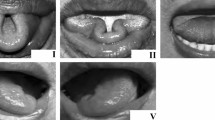Abstract
The present study was designed to obtain a comprehensive view of the dysphagia assessment practice patterns of speech–language pathologists and their opinion on the importance of these practices using survey methods and taking into consideration clinician, patient, and practice-setting variables. A self-administered mail questionnaire was developed following established methodology to maximize response rates. Eight dysphagia experts independently rated the new survey for content validity. Test–retest reliability was assessed with a random sample of 23 participants. The survey was sent to 50 speech–language pathologists randomly selected from the Canadian professional association database of members who practice in dysphagia. Surveys were mailed according to the Dillman Total Design Method and included an incentive offer. High survey (64%) and item response (95%) rates were achieved and clinicians were reliable reporters of their practice behaviors (ICC>0.60). Of all the clinical assessment items, 36% were reported with high (>80%) utilization and 24% with low (<20%) utilization, the former pertaining to tongue motion and vocal quality after food/fluid intake and the latter to testing of oral sensation without food. One-third (33%) of instrumental assessment items were highly utilized and included assessment of bolus movement and laryngeal response to bolus misdirection. Overall, clinician experience and teaching institutions influenced greater utilization. Opinions of importance were similar to utilization behaviors (r = 0.947, p = 0.01). Of all patients referred for dysphagia assessment, full clinical assessments were administered to 71% of patients but instrumental assessments to only 36%. A hierarchical model of practice behavior is proposed to explain this pattern of progressively decreasing item utilization.



Similar content being viewed by others
References
InstitutionalAuthorNameAssociation American Speech-Language-Hearing (1999) Omnibus Survey: Caseload Report: SLP ASLHA Rockville, MD
InstitutionalAuthorNameOntario Speech-Language-Hearing Association (1999) Average for Communication versus Swallowing in Adults. Health Care Professional Interest Group OSLHA Toronto
GH McCullough RT Wert JC Rosenbak C Dinneen (1999) ArticleTitleClinicians’ preferences and practices in conducting clinical/bedside and videofluoroscopic swallowing examinations in an adult, neurogenic population Am J Speech Lang Pathol 8 149–163
TW Mangione (1995) Mail Surveys: Improving the Quality. Sage Publications Inc Thousand Oaks, CA
Group Health Services (1992) ArticleTitleSmall-area variations: What are they and what do they mean? Can Med Assoc J 146 467–470
AR Feinstein (1987) Chapter 2: Nomenclature and functional classification of clinimetric indexes . (Eds) Clinemetrics Yale University Press New Haven, CT 6–21
A Donner M Eliasziw (1987) ArticleTitleSample size requirements for reliability studies Stat Med 6 441–448 Occurrence Handle1:STN:280:BiiA3MbitFE%3D Occurrence Handle3629046
LA Aday (1996) Designing and Conducting Health Surveys: A Comprehensive Guide, Vol. 2 Jossey-Bass Inc San Francisco, CA
DA Dillman (2000) Mail and Internet Surveys: The Tailored Design Method EditionNumber2 Wiley New York
DL Streiner GR Norman (1995) Health Measurement Scales: A Practical Guide to Their Development and Use Oxford University Press New York
JC Rosenbek JA Robbins EB Roecker JL Coyle JL Wood (1996) ArticleTitleA penetration-aspiration scale Dysphagia 11 IssueID2 93–98 Occurrence Handle1:STN:280:BymA3sbgt1U%3D Occurrence Handle8721066
NP Roos LL Roos (1991) Small area variations, practice style, and quality of care RP Wenzel (Eds) Assessing Quality of Care: Prospectives for Clinicians Williams & Williams Baltimore 223–238
R Martino G Pron NE Diamant (2000) ArticleTitleScreening for oropharyngeal dysphagia in stroke: Insufficient evidence for guidelines Dysphagia 15 19–30 Occurrence Handle1:STN:280:DC%2BD3c%2Fmt1KrtQ%3D%3D Occurrence Handle10594255
D Kidd J Lawson R Nesbitt J MacMahan (1993) ArticleTitleAspiration in acute stroke: A clinical study with videofluoroscopy Q J M 86 825–829 Occurrence Handle1:STN:280:ByuC2M7kslU%3D
MA Holas KL DePipp MJ Reding (1994) ArticleTitleAspiration and relative risk of medical complications following stroke Arch Neurol 51 1051–1053 Occurrence Handle1:STN:280:ByqD3s7ntVw%3D Occurrence Handle7945003
InstitutionalAuthorNameAssociation American Speech-Language-Hearing (1998) Clinical indicators for instrumentation assessment of dysphagia ASLHA Rockville, MD
Martino R, Meisssner–Fishbein B, Saville D, Barton D, Kerry V, Kodama S, Lbas–Weber M, McVilltie A, Mintz T, Tamas I: Preferred Practice Guidelines for dysphagia. College of Audiologists and Speech-Language Pathologists of Ontario (CASLPO), 2000 (http://www.caslpo.com/english_site/DYSPHAGIADOCUMENT.pdf)
JA Logemann (1993) Manual for the Videofluorographic Study of Swallowing, Vol 2 Pro-Ed Austin, TX
Acknowledgments
The authors thank the following dysphagia experts for their involvement in item generation: Cathy Lazarus, Jeri A. Logemann, JoAnne Robbins, Barbara C. Sonies, and Jonathan Aviv.
Author information
Authors and Affiliations
Corresponding author
Rights and permissions
About this article
Cite this article
Martino, R., Pron, G. & Diamant, N.E. Oropharyngeal Dysphagia: Surveying Practice Patterns of the Speech–Language Pathologist. Dysphagia 19, 165–176 (2004). https://doi.org/10.1007/s00455-004-0004-7
Issue Date:
DOI: https://doi.org/10.1007/s00455-004-0004-7




